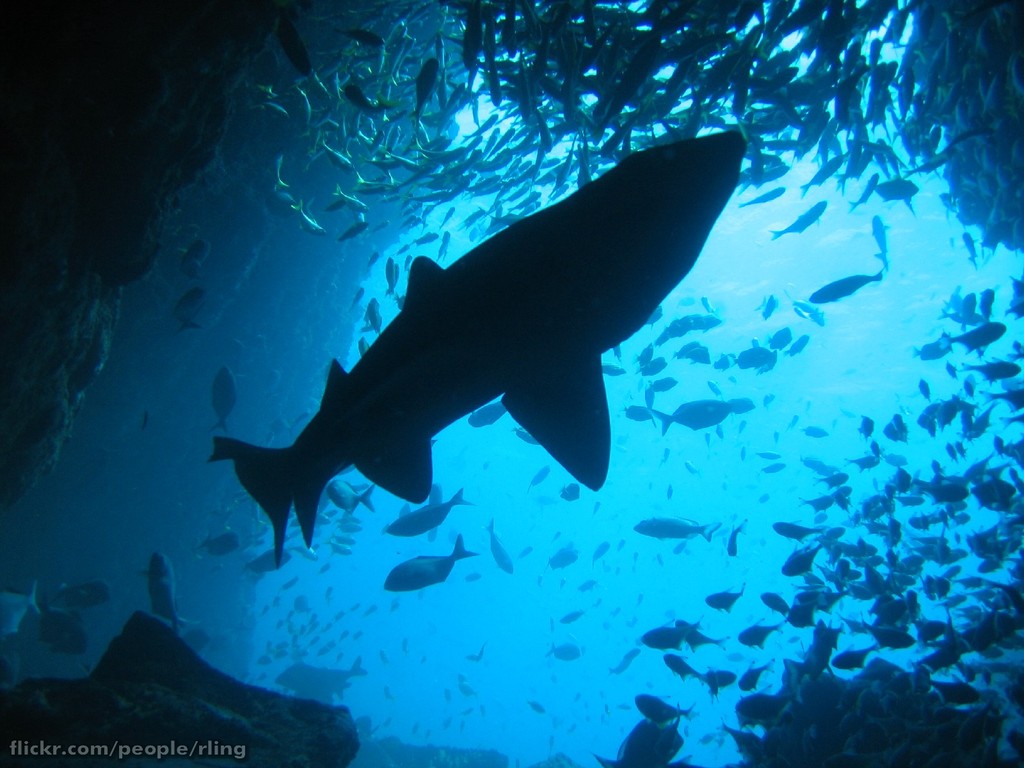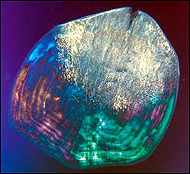Marine zones
Marine zones


The ocean is one big connected pot of water, but it has gradually distinct zones. Unlike lakes and streams that are relatively isolated from one another, the oceans are one big interconnected body of water. Yet the ocean has distinct zones with distinct inhabitants too.
Marine zones •
The light at the top •
Hiding in plain daylight •
Dealing with darkness •
Dealing with the cold •
Food •
Continental ties •
__________________________
In the big picture view, the greatest difference occurs between neritic and oceanic environments.
The neritic zone is the coastal zone or area closest to land. Fishes that live there may also be described as coastal, nearshore, or inshore. The neritic zone is distinct not just becasue of its closeness to land, but by the presence of the underlying continental shelf.
The nearby land influences this area in several important ways - by shedding mportant nutrients and sediments into coastal waters, by
? In comparison with the open ocean, the area of the continental shelf is shallow being less than 150 mbsl in most place. The continental shelf makes relatively shallow underlying ground that is less than 200 m deep. The depth of neritic seas coincide with the thermocline, mixed layer ... It is usually biologically productive and home to x of the fishes. Neritic areas are important fishing areas.
The oceanic environments are further from land and dominated by two layers, the uppermost epipelagic zone that is warmest, most sunlit, ..., and all the layers below that are relatively dark.
Find out what kinds of fishes live in each area.
The light at the top

Silhouettes of fish in a skyward-looking view.
The photic zone

 Click to view larger interactive.
Click to view larger interactive.
 Sources of uncertainty in our tree-of-life
Sources of uncertainty in our tree-of-lifeThe ocean is lit by the Sun from the top. One by one, the colors of the rainbow disappear into ocean until all colors of light eventually disappear, leaving total darkness.
Light is a kind of energy and since energy isn't destroyed, where did the light energy go? The molecules of water, the things dissolved in seawater that make it salty, dissolved gases and particles absorb it one-by-one. Red light is absorbed by the time it gets through a feet of seawater. Since you can't see light afer it has been absorbed by matter, you can't see the color red below a few feet. Once all the colors of light are absorbed, it's totally dark.
The sunlit part of the ocean is called the photic zone. Technically some light does down as far as. But the minimum threshold for photosynthesis is ... Even midwater fishes have large keen eye
Light is key to life because the energy in nearly every shred of food traces back to sunlight. Photosynthetic organisms like plants on land are the only organisms that can package energy into forms usable by living things. Direct application of sunlight only gives you a sunburn, but when it's captured in the structure of chemical compounds such s glucose, ...
Unlike on land, the organisms at the base of the food web aren't large bushes or trees. Even single blades dward the photosynthesizers in the sea - mostly single-celled diatoms, coccolithophores and bacteria that live where there's sunlight, within the uppermost sunlight waters.
The tiny plankton that graze on these animals aggregate close to the surface too. The larger animals that in turn each t... would cluster near the surface except for one problem with the sea. There is nowhere to hids.
ACTIVITY ideas
See how light passes through different materials.Seawater
Hiding in plain daylight
How do you hide in an empty lit room? Much of the ocean is like that. Living things congregate towards the sea surface where life-supporting sunlight ... But at the sea surface there are no rocks or bushes to hide behind. The only darkness lies several hundred meters below where the ...
It might seem dark even 10 meters down, because the human eye doesn't see that well in the dark without color. . Bonorum voluptaria repudiandae mea ex, sed te dictas sadipscing. Ut tation feugait voluptatum vis, nec at scripta blandit.
ACTIVITY
Interpreting images from above the water surface. Snell's law.In transparent waters of the surface open ocean, there aren't many places to hide from those that seek. Occasionally, there are seaweeds such as sargassum that grow floating at these surface to provide shelter, but not in most places. Even a hundred meters below where it's too dark for kelp or coral to grow, and you might consider it totally dark, there's enough light to see silhouettes in a twilight zone. To blend in with the view, many open ocean fishes have a kind of camoflauge pattern called countershading. A countershaded fish has a dark color on the top (dorsal) side and a light color on the abdomen (ventral) side.
The darkness itself provides cover so many fishes live in midwater below the sunlit photic zone. Some venture upward towards the surface in the darkness of night to feed on more abundant zooplankton and other fishes that stay closer to the surface, and return to the depths at sunrise. That explains why it's better to go fishing for some kinds of fish during the night. Learn more about this nightly vertical migration (diel migration) in the section on migrating fishes.
Many open ocean fishes do live in sunlit waters or pass through that zone during the day. Their environment is various shades of blue depneding on depths, dark looking down or lit .
Others never leave midwater depths and make do in a place with much less food. These organisms rely on the crumbs of food that sink from above. Some of these fishes have developed the oddest strategies to conserve the precious energy they ... in their food.
Countershading
Dealing with darkness
TBA
Bioluminescence
Dealing with saltwater
TO THINK ABOUT
The same principles apply to fishes in saltwater as freshwater with a major exception. In the case of many marine fishes, their body fluids are less saline than the water in their surroundings. These fishes lose water to their surroundings and must drink copious amounts of water rather than rid themselves of urine.
Hagfish
Hagfishes are exceptional because their body fluids are nearly isotonic with seawater. The close affinity between seawater and hagfishes may go back to their origins in the sea without ever having left.
Sharks are also exceptional because they have altered the chemistry of their body fluid to nearly match and just slightly exceed the salinity of seawater. Unlike other fishes, they dispose of some kinds of biochemical wastes such as urea and ... into their bloodstream to raise salinity. Sharks that aren't prepared properly may have a bad ammonia taste from urea that has been decomposed by bacteria. To prevent this, sharks for consumption need to be bled immediately after capture and iced to reduce the rate of decomposition.
Dealing with the cold
Ocean temperatures are extremely stable compared with land. Much of the deep sea never varies by even a degree outside of 2-5 ° (x (&neg; F). Surface water temperatures may vary from the tropics to the poles, but on a daily or seasonal basis, it doesn't vary as much as air temperature at the same latitude.
However, most of the ocean is very cold. Even through it's less than two-and-a-half miles down to the average depths of the open ocean, even tropical waters go from a balmy 80° C down to about 2°C above freezing ... As fishermen in the Bering Sea and other polar regions know too well, humans can only last a few minutes in near-freezing waters. Many fishes such as Swordfish regularly swim from the surface to over x m in search of food and othes live in polar waters that cold all the way to the surface. How do they do it?


Icefish


Swordfish
Brain heater

Dealing With Pressure
Food
Continental ties
TBA







